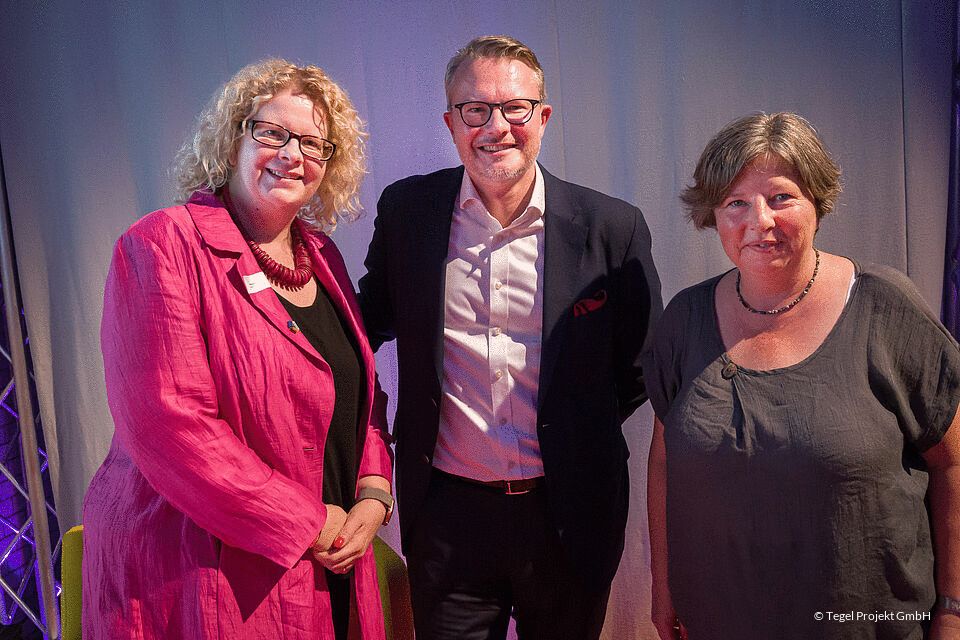It’s hot on this summer evening in June, well over 30 degrees. Even the trees in the courtyard of the Beuth University of Applied Sciences in Berlin can do little to counteract the heat. But the heat does nothing to dampen the great interest in the event: Over 100 guests accepted Tegel Projekt GmbH’s invitation to the Parliamentary Evening. For the second time since 2017, this political format gives them the opportunity to learn first-hand about the planning status and discuss the challenges and opportunities associated with urban development in Berlin’s northwest.
TENS OF THOUSANDS OF JOBS & BILLIONS IN INVESTMENT
Philipp Bouteiller, Managing Director of Tegel Projekt GmbH, makes it clear right at the start what is special about this development: “In the case of the Berlin TXL project and the adjoining Siemensstadt tens of thousands of jobs and investments of ten to twelve billion euros over the next 20 years in northwest Berlin. “What gravitas is being created there is new for this city,” Bouteiller is certain. And he points to the pleasing trend that jobs in Berlin have grown even faster than the number of inhabitants in recent years. With the help of Berlin TXL and Siemensstadt, this trend will continue. The participants of the Parliamentary Evening are also convinced that the city will benefit from further growth: 87 percent of the participants in the live voting said that they perceive growth as a “great opportunity” for Berlin.
BERLIN’S GROWTH AS A REASON FOR INVESTMENT
The project manager of Siemensstadt, Karina Rigby, agrees. The fact that “Berlin is growing like crazy” was one of the main reasons for Siemens’ commitment to the old headquarters – along with the investment climate in the city and the infrastructure promises of the Senate. Rigby, however, will have to wait a little longer than her colleague Bouteiller before her project can make a concrete contribution to growth. While the first excavators are scheduled to start rolling in Berlin TXL in 2021, Siemensstadt will need a few more years to develop into what Rigby calls a “neighbourhood of doers”. By that, the Berliner-by-choice means above all a “warm and liveable location and not a cold Silicon Valley”. Bouteiller also makes clear the obligations that Berlin’s growth brings with it. The demand for industrial and office space already exceeds the designated potential many times over. Berlin TXL and Siemensstadt are part of the solution, but by no means sufficient, says Bouteiller.
BERLIN MIX AS A GUIDING PRINCIPLE
What both projects have in common is that they are looking for new solutions for living together in the city of the future – and in doing so they are also continuing the approaches to urban development that have already proven successful. The Berlin mix, for example, i.e. the spatial proximity of living and working, is to play a major role in both projects. A large majority of viewers in the live voting were also convinced that this spatial proximity should continue to function as a guiding principle in urban development. This principle is complemented by a number of innovative approaches in the areas of mobility, energy and housing. The Schumacher Quartier in Berlin TXL, for example, will implement a largely car-free traffic concept and promote particularly low-emission forms of mobility. Equally innovative and an exciting example of the many potential synergies of the two projects is the new energy concept of Berlin TXL. With the help of its partners E.ON and Berliner Stadtwerke, Tegel Projekt GmbH will be implementing a new type of low-temperature grid there over the next few years. Such a LowEx network would be all the more efficient, Bouteiller emphasised, the more actors were involved in it and promoted an extension of the network, e.g. in the direction of Siemensstadt.
LIGHTHOUSES FOR THE DEVELOPMENT OF THE CITY
Katrin Lompscher, Senator for Urban Development and Housing, is convinced that the two projects represent “a great modernisation and development opportunity” for Berlin. One example is the city’s infrastructure, where the two projects have high standards and the city still has some catching up to do. Meeting these demands makes the two projects “beacons for the development of the city”. The potential for modernisation is exemplified by the transport connections of the two projects. In addition to the extension of the Siemensbahn to Siemensstadt, Katrin Lompscher also promised an expansion of the public transport connection for the Berlin TXL site.
Parliamentary Evening Berlin TXL 2019 | Berlin TXL meets Siemensstadt 2.0. Click here for the video.
BERLIN TXL AND SIEMENSSTADT 2.0 AS THE BIG RE-INDUSTRIALISATION PROJECTS
However, the Urban Tech Republic and Siemensstadt in particular are of special importance for the re-industrialisation of Berlin, as Monika Gross, President of the Beuth University of Applied Sciences and host of the evening, emphasised. And she offers advice on how best to master the final steps on the home stretch for Berlin TXL. In the past years, she said, it had been crucial for the success that so many players had worked together to make the after-use a success. And only together can the final steps be taken.
